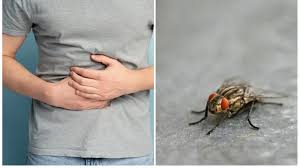Potential Spread of Parasites Through Fly
DOI:
https://doi.org/10.31965/jtdhs.v3i2.2232Keywords:
Fly density, Flies, Worm EggsAbstract
Parasites that can be transmitted by flies include Ascaris lumbricoides, Trichuris trichiura, and hookworm eggs. The purpose of this study was to determine the potential for parasite spread through flies in food stalls at the Naikoten 1 Inpres Market, Kupang City. This type of research is descriptive research. The research variables are fly density levels, fly types, and parasites on fly bodies. The sample in this study was 4 food stalls that have the potential for parasite transmission at the Naikoten 1 Inpres Market, Kupang City. Data collection methods were obtained by measuring fly density levels using a Flygrill, as well as examining fly types and parasites on fly bodies using a microscope. The results of the fly density measurement study at food stalls at the Naikoten 1 Inpres Market, Kupang City were categorized as low (100%). The types of flies caught were 95% Musca domestica (house flies) and 5% Sarcophaga flies. The results of the worm egg examination found 35% Ascaris lumbricoides and 5% Trichuris Trichiura. For this reason, there needs to be socialization and community empowerment in food and drink sanitation so that the chain of transmission of worm eggs to humans can be broken through fly control and attention to the cleanliness of sales locations.
Downloads
References
Andiarsa, Dicky. (2018). Lalat: Vektor yang Terabaikan Program? Balaba: JurnalLitbang Pengendalian Penyakit Bersumber Binatang Banjarnegara, 14.
Ayodya, Wulan. 2007. Kursus Singkat Usaha Rumah Makan Laris Manis. Jakarta: PT Elex Media Komputindo. http://webcache.googleusercontent.com/search?q=cache:4wXzvK--wuUJ:repository.unika.ac.id/11136/7/12.30.0111%2520Koo%252C%2520Yenny%2520Yuliani%2520W%2520DAFTAR%2520PUSTAKA.pdf&cd=1&hl=id&ct=clnk&gl=id
Depkes RI, 2008, Profil Kesehatan Indonesia, Jakarta
Disperindag NTT, “Laporan Akuntabilitas Kinerja Instansi Pemerintah, Dinas Perindustrian dan Perdagangan Provinsi Nusa Tenggara Timur,Tahun 2017 Disperindag NTT,DepartemenPerindustrian RI”
Dwi meidyana putri, Ni made, (2019). Gambaran tingkat kepadatan lalat. Politeknik kesehatan kemenkes Denpasar
Ekaputra, E. (2013). Evolusi Manajemen Luka : Menguak 5 Keajaiban MoistDressing. Jakarta : Trans Info Medika.
Entjang, (2000). Ilmu kesehatan masyarakat. PT Citra Aditya. Bandung.
Jannah, D.N., 2006. Studi di TPS Pasar Beras Bendul Merisi. Surabaya.Universitas Airlangga Fakultas Kesehatan Masyarakat.
Gandahusada, Srisasi, Herry D. Ilahude, Wita Pribadi, (2006). Parasitologi Kedokteran, Edisi Ketiga, Penerbit Fakultas Kedokteran UI, Jakart.
Hadi, U & Sigit, S., 2006. Hama Pemukiman Indonesia Pengenalan Biologi & Pengendalian Unit Kajian Pengendalian Hama Permukiman (UKPHP). Bogor: Institut pertanian bogor.
Hastutiek & Fitri, L. 2007. Potensi Musca domestica Linn. sebagai Vektor Beberapa Penyakit. JurnalKedokteran Brawijaya, 23: 125-136. https://webcache.googleusercontent.com/search?q=cache:4PpaCDf8o1UJ:https://journals.ums.ac.id/index.php/bioeksperimen/article/download/8988/6057&cd=2&hl=id&ct=clnk&gl=id
Husain S., 2014. Pengaruh Variasi Warna Fly Grill Terhadap Kepadatan LalatDi Tempat Pelelangan Ikan (TPI) Kota Gorontalo. UniversitasNegeri Gorontalo.http://webcache.googleusercontent.com/search?q=cache:xQL9bFM0osEJ:repository.unhas.ac.id/2535/3/H41116505_skripsi%2520dp.pdf&cd=3&hl=id&ct=clnk&gl=id
Kementrian Kesehatan RI, Profil Kesehatan Indonesia, 2014, Dayu Sadnyawati.
Margono S. 2008. Nematoda Usus Buku Ajar Parasitologi Kedokteran.
Mulia, Ricki M. 2005. kesehatan Lingkungan. Yogyakarta: Graha Ilmu http://webcache.googleusercontent.com/search?q=cache:gsdhU0yH0K8J:repository.unhas.ac.id/8048/3/dessynatal-851-1-skripsi-a%2520dapus-lam.pdf&cd=3&hl=id&ct=clnk&gl=id
Putri, Zulfina Eka (2019) Uji Efektivitas Ekstrak Daun Pandan Wangi (Pandanus amaryllifolius Roxb) sebagai Insektisida terhadap Lalat Rumah (Musca domestica). Undergraduate (S1) thesis, Universitas Islam Negeri Alauddin Makassar. http://webcache.googleusercontent.com/search?q=cache:-5zkNKxqe6AJ:repositori.uin-alauddin.ac.id/16112/&cd=3&hl=id&ct=clnk&gl=id
Rahmawati, Yuli. P. (2014). Ketertarikan Lalat Buah Bactrocera Sp. PadaSenyawa Atraktan Yang Mengandung Campuran Protein Dan MetilEugenol. Skripsi Prodi, UNNES: Tidak Diterbitkan. http://webcache.googleusercontent.com/search?q=cache:WoSoTx3C6dkJ:repository.unpas.ac.id/29222/8/15.%2520DAFTAR%2520PUSTAKA.pdf&cd=6&hl=id&ct=clnk&gl=id
CalRecycle, 2012, Penyakit Yang di Tularkan Lalat Serta TindakanPengendaliannya. Fakultas Kesehatan Masyarakat Sriwijaya.
Sigit HS, FX Koesharto, UK Hadi, DJ Gunandini dan S Soviana. Hama Pemukiman Indonesia, Pengenalan, Biologidan Pengendalian. Unit Kajian Pengendalian Hama Permukiman (UKPHP), Fakultas Kedokteran Hewan IPB. 2006.Sembel, D. T. (2009) Entomologi Kedokteran. Yogyakarta: Andi Offset.
Soebaktiningsih, 2004, Identifikasi Jenis-jenis Lalat yang Ditemukan di Tempat Sampah Pasar Dinoyo, Kota Malang.
Sucipto, C.D. 2011. Vektor Penyakit Tropis. Yogyakarta: Goysen Publishing
Suraini. 2011. Jenis - Jenis Lalat (Diptera) Dan Bakteri Enterobacteriaceae YangTerdapat Di Tempat PembuanganAkhir Sampah (TPA) Kota Padang [Tesis].Padang: Program Pascasarjana Universitas Andalas. http://webcache.googleusercontent.com/search?q=cache:WX8USl13lmAJ:jurnaldampak.ft.unand.ac.id/index.php/Dampak/article/download/48/32&cd=5&hl=id&ct=clnk&gl=id
Suyono, Budiman, (2011). Siklus hidup lalat. Saputri
Susilowati. (2017). Hubungan Sanitasi Lingkungan dengan Tingkat Kepadatan Lalat Di Pasar Tradisional Kecamatan Tembalang . Skripsi. Universitas Muhammadiyah Semarang . (Online). http://repository.unimus.ac.id/992/ (Diakses pada 20 Desember 2022). https://journal.poltekkes-mks.ac.id/ojs2/index.php/Sulolipu/article/view/1478
Tanjung, N., 2016. Efektivitas Brbagai Bentuk Fly Trap dan Umpan DalamPengendalian Kepadatan Lalat Pada Pembuangan Sampah Jalan BudiLuhur Medan. Penelitian, 11(3), 217–222. http://webcache.googleusercontent.com/search?q=cache:kSZK9aU6Qw0J:eprints.poltekkesjogja.ac.id/923/8/8%2520DAFTAR%2520PUSTAKA.pdf&cd=2&hl=id&ct=clnk&gl=id
Wintoko, R(2014). Hubungan aspek personal hygiene dan aspek perilaku dengan risiko kontaminasi kuku telur cacing pada siswa kelas 4, 5, dan 6 SD Negeri 2 Kabupaten Raja Basa Bandar Lampung tahun pelajaran 2012/2013. Jurnal Kesehatan Universitas Lampung.

Downloads
Published
How to Cite
Issue
Section
License
Copyright (c) 2025 Journal of Tropical Diseases and Health Science

This work is licensed under a Creative Commons Attribution-ShareAlike 4.0 International License.





